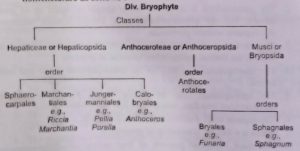Q.2. Discuss the biological and economic importance of Bryophytes. Classify Bryophyta giving reasons.
Ans.2. In general the economic importance of bryophytes is very little. On the whole none of them is directly important to man except a number of species of Sphagnum. The dried plants of Sphagnum are use as an absorbent in surgical dressing as a packing material for transhipment of living plants, as a material to increase the water retaining properties of certain poor type of soil and as a means of retaining high soil acidity required by certain decorative and economically important plants.
The mosses ecologically are of much importance. They are helpful in soil formation, in soils production, and in soil conservation. They provide the essential steps in the development of soils, because they can grow even in dry rocks where growth of higher plant is impossible. In due course of time their plant body dies and decay forming humus. The humus increases the fertility of soil.
Some Mosses provide food for fishes, herbivorus animals, birds, etc. They also have aesthetic value. For the more details see appendix.
Classification of Bryophytes
Following characters of bryophytes are used for their classification:
(i) Structure of thallus
(ii) Anatomy of the thallus
(iii) Types of rhizoids
(iv) Types of scales
(v) Position of sex organs
(vi) Structure of sporophyte
(vii) Nature of sporophyte
(viii) Degree of sterilisation in sporophyte.
The group bryophyta which is a smaller group consisting of nearly 96 genera and 24000 species has been variously classified by different workers from time to time. The important work of various botanists regarding the classification of bryophytes is as follows:
- Braun (1864)-First of all introduced the name bryophyta, but he included Algae, Fungi, Lichens and Mosses in it.
- Schimper (1879)-gave Bryophyta (Atracheata by Tippo 1942), the rank of division.
- Eichler (1883)—divides bryophytes into two classes viz.
(1) Hepaticeae. (2) Musci.
4 Engler (1892)-divided class Hepaticeae into three orders viz.
(i) Marchantiales.
(ii) Jungermanniales.
(i) Anthocerotales.
This classification has been still followed by a large number of botanists like Wettstein (1933-35), Bower (1938), Evans (1932), Engler, Melchor and Werdermann (1954).
- Underwood (1884)-made minor modification by taking out Anthocerotales from hepaticeae and gave a rank of class to the order Anthocerotales.
- Gayet (1897), How (1899), Campbell (1913, 1940), Smith (1938), (1955), Takhtajan (1953), etc. divided bryophytes into three subclasses viz. Hepaticeae Athocerotae and Musci.
- Rothmoler (1951)-has classified the bryophytes into three classes, according to the latest recommendation of the international code of nomenclature as follows:

8 Prokauer (1957)-suggested the name Anthocerotopsida for Anthoceropsida. Thus, the modern bryologists classify Bryophyta into the following three classes:
(a) Hepaticopsida
(b) Anthoceropsida
(c) Bryopsida
- Schuster (1958)-called the Anthocerotopsida as Anthoceroteae.
- Most of the Bryologist such as Takhtajan (1953), Smith (1955), Wardlow (1962) and Schuster (1958, 1966) classified bryophytes into Hepaticeae Anthocerotae and Musci.